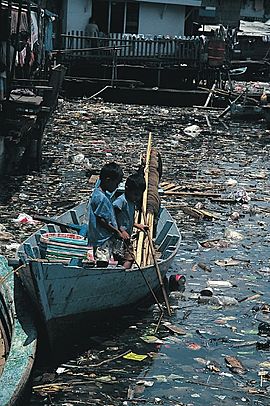Ocean pollution facts for kids

Ocean pollution is pollution in the sea. It is a form of water pollution. It happens when chemicals and other forms of pollution enter the ocean. Most sources of ocean pollution come from everyday people doing everyday things. It is called nonpoint-source pollution because we cannot directly locate from where it came. All wastewater, in time, enters a body of water (usually a stream). Every stream leads to a river, and every river leads to an ocean.
Contents
Toxins
Harmful materials such as sewage, dissolved metals, waste from farms or factories, and crude oil spilled from oil tankers pollute the ocean. The three main substances that pollute water are nitrates from fertilizers, sewage, and detergents. When toxic chemicals and metals enter the water, the smallest animals like plankton eat them. When larger animals eat the smaller ones, they are eating the toxins as well, which can cause mutations, diseases, and reproduction difficulties.
Nutrient pollution
Activities like bathing or washing clothes near a stream or river result in nutrient pollution. Nutrient pollution happens when too many nutrients like nitrogen and phosphorous enter the water and eventually travel to the ocean. This leads to the growth of too much algae on the surface of the water. This algae blocks the penetration of sunlight and air into the water.
Plastic pollution
Marine plastic pollution (or plastic pollution in the ocean) is a type of marine pollution by plastics. These plastics can range in size from large original materials like bottles and bags to microplastics and nanoplastics, which are very small pieces of plastic. About eighty percent of marine debris is plastic. Plastic garbage that floats on or in the ocean's water is known to harm marine life (plants and animals that live in the ocean). They can become entangled in it or suffocated by it. Plastics that are small enough to be eaten or breathed (intentionally or unintentionally) by animals harm their organs.
Saving the ocean
Humans have done much to harm the ocean, but we are starting to try to help them. Countries promise each other to clean up the ocean and save the ocean's resources. Many countries have made special agencies whose only purpose is to help the environment.
Interesting facts about ocean pollution
- Ocean pollution kills more than one million sea birds each year.
- The five most common items found in coastal cleanups around the world are all single-use plastics.
- There are more microplastics in the ocean than there are stars in the Milky Way.
- Fish and other marine life often can’t tell the difference between plastic and food. If the animal eats plastic, they can’t digest it. The plastic fills their stomachs, so they starve to death.
- Noise pollution made by shipping and military activity can cause cellular damage to a class of invertebrates that includes jellyfish and anemones.
- 100,000 marine animals (animals that live in the ocean) die each year from being tangled in plastic.
- There is an ocean garbage patch twice the size of Texas.
- Oceans contain dead zones that have been created by pollution making life in those zones impossible for marine or plant life.
Images for kids
-
A graph linking atmospheric dust to various coral deaths across the Caribbean Sea and Florida.
-
An island with a fringing reef in the Maldives. Coral reefs are dying around the world.
-
Marine debris removal in the Northwestern Hawaiian Islands (NOAA removed approximately 57 tons of derelict fishing nets and plastic litter from the Papahānaumokuākea Marine National Monument's tiny islands and atolls, sensitive coral reefs and shallow waters).
-
The Great Pacific garbage patch causes vast quantities of trash to wash ashore at the south end of Hawaii.
See also
 In Spanish: Contaminación marina para niños
In Spanish: Contaminación marina para niños











